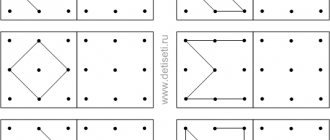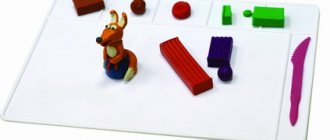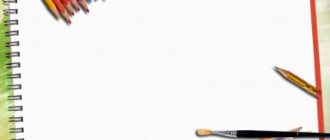If you are the parent of a preschooler, you have probably already thought about starting school. How to help adapt to new conditions, master writing, counting and reading.
In this material we will help you understand the main aspects of developing writing skills, find out possible mistakes and how to avoid them. We'll tell you about exercises and educational games that will help prepare your hand for writing.
Formation of writing skills in children
Writing is one of the ways of speaking. The process of developing a skill is long and complex. It starts at the age of two or three and continues until the age of seven, when children enter first grade. Many parents start preparing their children for school in advance. They buy notebooks with copybooks of letters, and do not understand why many days of hard training do not produce results.
It is important to know the difference between preparing to write and learning to write. In preschool age, full-fledged writing is impossible due to age-related characteristics of the structure of the nervous system. At this stage, the emphasis is on general physical development and strengthening the muscles of the hand, on developing perseverance, coordination of body movements, concentration, and visual orientation.
Writing skills are developed in three stages:
- analytical - thinking about each movement and analyzing it, for example, how it is more convenient to take the handle, with what force to press, etc.
- synthetic – combining elements into a holistic process, conscious thinking about each step, visual control of each action;
- automation means that the skill has been formed: the child, without thinking, completes written tasks, hand movements are smooth, effortless.
In preschool age, the child gains graphic experience, learns to use written objects and observe hygiene rules. The child acquires the skills to correctly tilt a notebook, write individual letters and words of the required size and at the required angle, and correct body position while writing.
The benefits of mathematical dictations
Graphic dictation for preschoolers is a useful technique for diagnosing the level of development and preparing for school in kindergarten and at home. In preschool educational institutions, educators more often use manuals by the authors: D.B. Elkonina, O.A. Kholodova. K.V. Shevelev developed a whole course of step-by-step lessons for children 4–5 years old, 5–6 years old, as well as first-graders. Shevelev’s special notebooks develop the following skills and abilities in preschool children from the preparatory group:
- coordination of movements;
- attention;
- memory;
- perseverance;
- imagination;
- lexicon;
- fine motor skills;
- spelling vigilance.
At the same time as physical skills, the child increases self-esteem. He is aware of the need to listen to instructions. Does the job clearly and quickly, without being distracted by a bird in the window or the laughter of a neighbor at his desk.
Another goal of graphical mathematics is to broaden one's horizons. You need to select pictures according to the age and level of development of the children, but this is only at first. Later, draw pictures that are unfamiliar to preschoolers. After drawing such an arithmetic problem on a piece of paper, tell a story about an unusual animal, introduce it to its habitat, and show a photograph.
Numerical dictation assignments are a good way to adapt kindergarteners to school. They teach six-year-olds independence and orientation in a new space. This will help in mastering the elementary school curriculum, when meeting a new team and teacher.
The ability to hold a pencil, follow oral instructions, decipher text, and write is an excellent foundation for preparing for first grade.
You can ask your child to print out sheets, templates, and help interpret instructions. This helps to introduce the future preschooler to office equipment and instill respect for elders.
What is important for preparation
In order to facilitate the process of developing writing skills, reduce stress and not cause a negative attitude towards school, it is necessary to train the hand from the age of three.
General physical development
Good physical fitness plays an important role in the formation of beautiful handwriting. Strengthening the muscular system promotes endurance and allows you to sit at your desk during the lesson. Strong back muscles prevent curvature of the spine and maintain correct posture. Developed muscles of the shoulder girdle and arms relieve rapid fatigue, trembling and muscle spasms.
The child develops physically during active games on the street, riding a bicycle or scooter, jumping on a trampoline or inflatable slide, etc.
Motor skills
These are coordinated movements aimed at performing some action.
Motor skills are divided into:
- large – this is coordination of movements, maintaining balance, awareness of the position of the body in space: walking, running, standing up, sitting down, lying down, turning;
- fine - precise movements of the fingers.
To develop writing skills, it is equally important to pay attention to the development of both types of motor skills. When writing, the small muscles of the hand and the large muscles of the body are used to keep the body in a straight position.
Orientation in space
It will be easy for a child to navigate in a notebook or on a piece of paper if he knows such concepts as right-left, top-bottom, side, center, corner. To do this, when talking with your baby while dressing and undressing, walking, bathing, feeding, pay his attention to what the right and left arms or legs are doing. Ask what is seen ahead and what is left behind.
Graphic skills
In the process of drawing, the muscles of the hand are trained. Hatching, coloring, and drawing in cells develops the skill of observing boundaries, writing hygiene, and the ability to navigate in space.
"Skillful Hands"
An integrated approach to developing skills, which includes various kinds of crafts, appliqués, modeling, design, knitting and embroidery. Fine motor skills, spatial orientation, perseverance, concentration, and accuracy are improved.
Exercises to prepare your hand for writing
There are many interesting activities for preschoolers that help prepare for writing:
- drawing with pencils on paper;
- prettification;
- tracing drawings along the contour;
- the use of special notebooks with copybooks of loops, hooks, figures, lines;
- shading of figures;
- drawing with multi-colored crayons;
- different types of mosaics;
- construction games with parts of different sizes;
- cutting with scissors;
- sorting beads, buttons by color or size;
- threading laces through holes;
- braiding braids from multi-colored ropes;
- winding ropes and knitting threads into a ball;
- spinning the spinning top toy, spinning top;
- stringing beads on a thread;
- simple embroidery elements;
- fastening and unfastening buttons, snaps, zippers;
- finger painting using paints, dry crumbly finely ground cereals, flour;
- modeling from plasticine, dough;
- games in the sandbox or with kinetic sand;
- gluing small parts using tweezers;
- drip drawing using a pipette;
- opening and closing the lock with a key;
- unscrewing and tightening screws and nuts with fingers and a screwdriver;
- sewing on a button;
- making applications from colored paper, pasta, natural materials (beans, peas, leaves, flowers, sticks, straws, matches, etc.);
- origami;
- drawing using stencils;
- finger theater games.
Execution Rules
Graphic dictations, during which you need to draw a geometric pattern, are best used in math lessons, for example in 1st grade. Execution is related to the coordinate system, counting, and geometric shapes. The methodology consists of several stages:
- Prepare a piece of squared paper for the student. Keep a ready-made version of the dictation with you.
- Place a dot on the student paper. This will be the start of the countdown. Or have your preschooler do it themselves, explaining how much space to give.
- For a child just beginning to learn, draw arrows on paper that indicate the directions of the sides. This makes it easier to get the correct result. In subsequent lessons, hints will no longer be needed.
- Explain that step 1 is a cage. If we take 2 steps, the line goes 2 cells.
- The teacher dictates the working conditions step by step.
On the finished sheet for the teacher there is a drawing, a coordinate plane consisting of arrows and numbers. For example, to draw a Christmas tree, draw a line horizontally in 1 cell, vertically - 3 cells, diagonally - 3 cells, and so on. More often it’s just arrows and numbers without words.
The teacher explains which lines, where, and at what distance the preschoolers draw. Instructions are given one after another, without rushing.
- After completing the written assignments and obtaining the results, draw conclusions about the lesson and the efforts of the preschoolers.
Scold him for inattention if the child was distracted by trifles, or praise him for achievements and a well-done task.
Important ! There's no need to rush. If your preschooler doesn’t keep up, usually in the first lessons, wait for him. Skipping even one step or writing incorrectly will ruin the finished result. Set the time frame gradually, speeding up the process by a couple of seconds from lesson to lesson.
Exercises
Regular exercises will help strengthen your hand muscles and add confidence in writing:
- "Blooming Flower"
The hands are clenched into fists and connected together. The thumbs are straight, touching the lateral surfaces. Then the fingers are straightened, the palms are slightly moved away from each other, the wrists are connected. Reminds me of an unopened bud. The flower begins to open - without separating the wrists, the hands are moved to the sides, the fingers are spread out.
- "Duckling fingers."
The palm is open, fingers spread. The index finger is curled into a hole at the base of the thumb. The pads of the first finger alternately touch the middle, ring and little fingers, like the beak of a duck.
- "Tight hugs."
The fingers of both hands are spread out, pressing the tips against each other with force for 5 seconds. Then they cross into a lock, pressing their palms tightly. Count to 5. After the exercise, shake your hands to relax the muscles.
- "Chair".
Place your palms together, fingers together, looking up. The right hand slides downwards along the left. When your fingertips reach the top of your left palm, you need to stop. By pressing at the base of the fingers of the left hand, the hand bends at the wrist joint. In this case, the fingers remain in a vertical position. The curved palm resembles a chair with a backrest.
- "Welcome handshake."
The index, middle and ring fingers of the right hand are pressed against the palm. Each finger of the left hand is greeted with the thumb and little finger, as if shaking with both hands during a greeting.
How to teach a child to hold a pen correctly
It is important that the child learns how to properly hold a pen and pencil before entering school. Correcting mistakes and retraining the grip is difficult. Incorrect position of the fingers, tilt of the pen and rotation of the hand make handwriting uneven and illegible, cause rapid hand fatigue, and affect posture.
What a correct grip looks like:
- the handle lies between the thumb and middle finger, pressed on top with the index finger;
- the distance to the writing rod is about two centimeters;
- a straight line can be roughly drawn through the hand, wrist and elbow joints;
- the top of the pen or pencil points to the child's shoulder.
The most common mistakes
Preschool children, when they begin to master working with stationery items, make the following mistakes:
- The child holds a pencil or felt-tip pen with his whole hand, clenching it into a fist.
- In a three-finger grip, the thumb is bent and directed perpendicular to the index finger to its middle phalanx.
- The pen rests on the ring finger and is held by the middle, index and thumb.
- The brush bends inward, with the top edge of the object pointing away from you.
- The child holds the handle with all fingers (like a pinch).
- The fingers are located near the stylus, or far away so that the hand hangs over the table.
- When moving, it presses on the paper too much, leaving tears, or too lightly.
Methods to avoid mistakes
The following methods will help you avoid mistakes in learning to retain written objects:
- It will be easier to grip a pencil correctly if you hold a small piece of paper with your ring and little fingers.
- Draw a dot on the middle finger that will indicate the location of the pen.
- The finger game “building a house” will focus on three-finger holding: the handle is held between the middle and thumb; the index finger rises freely and can hit the handle like a hammer.
- Be sure to focus on the direction of the top of the pencil towards the child’s shoulder.
- To generate moderate pressure, use soft pencils or felt-tip pens.
- For optimal removal of fingers from the lead, mark a line on the writing object where to hold it.
Is your child ready for school?
How to determine if a child is ready to write? For this purpose, teachers have compiled many tests. For example, the Kern-Jorasick “School Maturity” test (easy to find on the Internet) is aimed, among other things, at determining whether the future student’s hand is properly prepared.
You can ask your child to complete the following tasks:
- Show your preschooler a drawn circle with a diameter of 3 - 3.5 cm. Ask him to draw exactly the same one. When evaluating assignment performance, consider the following:
- The child must draw a figure close in size to the original one.
- The circle should resemble a circle (even if not perfectly smooth), not like some other geometric figure.
- The line should be solid (continuous), smooth, and fairly confidently drawn.
- The pressure should not be too weak.
- The child’s movements when completing the task should be free and confident.
- Ask your preschooler to shade any simple silhouette (cloud, ball, pear). If your child has not done shading before, show him a sample. The child can choose the direction of the shading (horizontally, vertically, diagonally). When evaluating the results, consider:
- Evenness and parallelism of lines. Accuracy of execution.
- Precision of movements.
- Maintain approximately the same spacing between lines.
Note! If the small muscles of the hand are not well developed, then the child will turn over the sheet on which he is working, because it will be easier for him to do this than to arbitrarily change the direction of movement of the hand.
Even if your child doesn’t start school this year, do these tests and you will see whether your baby’s hand needs to be prepared more carefully and purposefully. If yes, then use the methods suggested in the article or come up with your own. And everything will work out for you.





